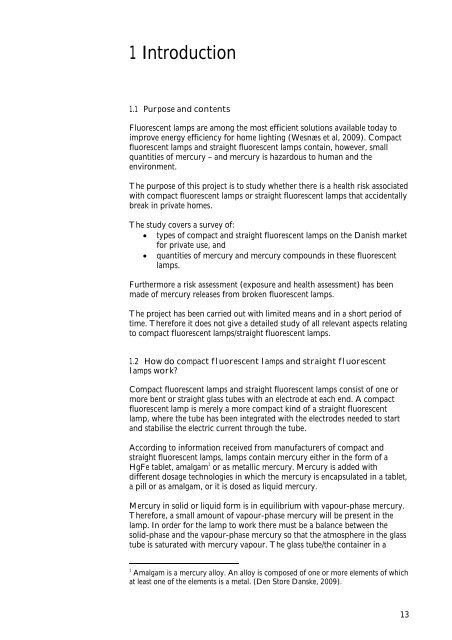No. 104 - Miljøstyrelsen
No. 104 - Miljøstyrelsen
No. 104 - Miljøstyrelsen
You also want an ePaper? Increase the reach of your titles
YUMPU automatically turns print PDFs into web optimized ePapers that Google loves.
1 Introduction<br />
1.1 Purpose and contents<br />
Fluorescent lamps are among the most efficient solutions available today to<br />
improve energy efficiency for home lighting (Wesnæs et al, 2009). Compact<br />
fluorescent lamps and straight fluorescent lamps contain, however, small<br />
quantities of mercury – and mercury is hazardous to human and the<br />
environment.<br />
The purpose of this project is to study whether there is a health risk associated<br />
with compact fluorescent lamps or straight fluorescent lamps that accidentally<br />
break in private homes.<br />
The study covers a survey of:<br />
� types of compact and straight fluorescent lamps on the Danish market<br />
for private use, and<br />
� quantities of mercury and mercury compounds in these fluorescent<br />
lamps.<br />
Furthermore a risk assessment (exposure and health assessment) has been<br />
made of mercury releases from broken fluorescent lamps.<br />
The project has been carried out with limited means and in a short period of<br />
time. Therefore it does not give a detailed study of all relevant aspects relating<br />
to compact fluorescent lamps/straight fluorescent lamps.<br />
1.2 How do compact fluorescent lamps and straight fluorescent<br />
lamps work?<br />
Compact fluorescent lamps and straight fluorescent lamps consist of one or<br />
more bent or straight glass tubes with an electrode at each end. A compact<br />
fluorescent lamp is merely a more compact kind of a straight fluorescent<br />
lamp, where the tube has been integrated with the electrodes needed to start<br />
and stabilise the electric current through the tube.<br />
According to information received from manufacturers of compact and<br />
straight fluorescent lamps, lamps contain mercury either in the form of a<br />
HgFe tablet, amalgam 1 or as metallic mercury. Mercury is added with<br />
different dosage technologies in which the mercury is encapsulated in a tablet,<br />
a pill or as amalgam, or it is dosed as liquid mercury.<br />
Mercury in solid or liquid form is in equilibrium with vapour-phase mercury.<br />
Therefore, a small amount of vapour-phase mercury will be present in the<br />
lamp. In order for the lamp to work there must be a balance between the<br />
solid-phase and the vapour-phase mercury so that the atmosphere in the glass<br />
tube is saturated with mercury vapour. The glass tube/the container in a<br />
1 Amalgam is a mercury alloy. An alloy is composed of one or more elements of which<br />
at least one of the elements is a metal. (Den Store Danske, 2009).<br />
13

















